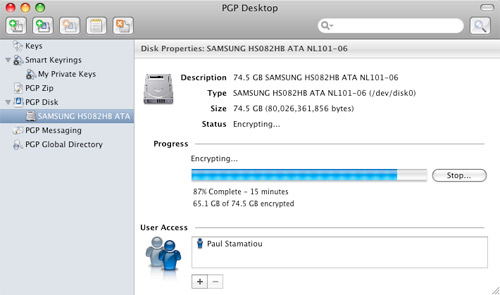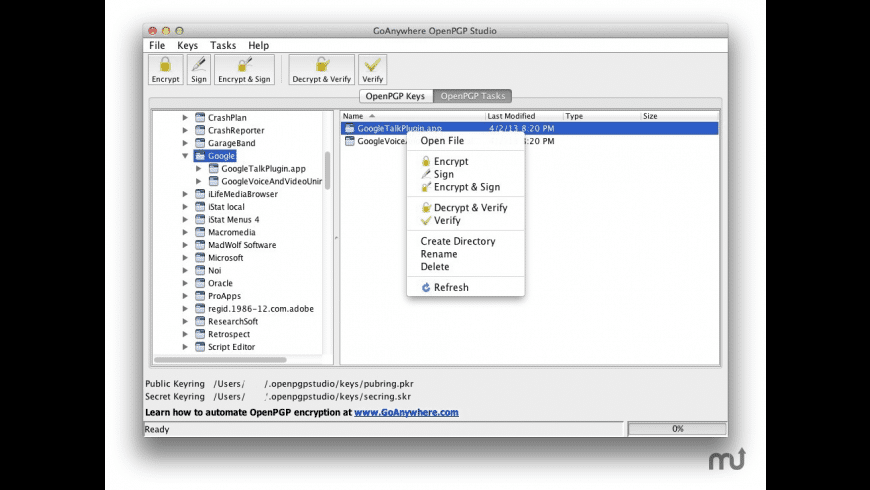
Questions On Pgp For Mac
Graphpad prism 5 free download. Why This PGP Q&A? When I began this FAQ, my primary intention was to bridge the gap between then existing PGP FAQs and the use of Windows versions of.
Symantec Encryption Desktop (PGP) for Mac is no longer available. Dell Data Protection Encryption (DDPE) will be replacing PGP for macs, please click here for more information!
Symantec Encryption Desktop (PGP) Mac OS X system requirements
- Apple Mac OS X 10.7.x, 10.8.x, 10.9.x
- Intel Processor
- 512 MB of RAM
- 64 MB hard disk space
- Desktop or laptop disks, including solid-state drives
- External disks, excluding music devices and digital cameras
- USB flash disks
- Disks formatted using the APM partition scheme
- Any type of server hardware, including RAID disk drives
- Diskettes and CD-RW/DVD-RWs
- Apple Mail 3.5, 4.0 Microsoft Entourage 2008 SP1
- Entourage is compatible for POP/IMAP only. 'Exchange Mode' is supported when using the Entourage Scripts included with Symantec Encryption Desktop (PGP). Automatic proxying is not supported with the scripts. For more information on using the scripts, see 'Integrating with Entourage 2008' in the Symantec Encryption Desktop (PGP) for Mac OS X User's Guide
- Lotus Notes 8.5.2
- Microsoft Outlook for Mac 2011
- iChat 4.0, 5.0 SL
- Other instant messaging clients may work for basic instant messaging, but have not been certified for use

- Norton Antivirus 11 and Norton Internet Security 3.0: To use Symantec Encryption Desktop (PGP) with email and instant messaging, you must disable the Vulnerability Protection option in Norton. To do this, select Auto Protection and then disable the option for Vulnerability Protection.' [18130]
- ClamXav: ClamXav is not compatible with PGP WDE on Mac OS X systems. [25682]
- VirusBarrier X6: VirusBarrier X6 is not compatible with PGP WDE on Mac OS X systems. [28849]
Install Instructions
If using another disk encryption software, decrypt and if applicable remove the other encryption software before installing Symantec Encryption Desktop (PGP). Ex. FileVault, Checkpoint FDE
- Download the client installer from http://software.ucsf.edu/applications/pgp.html
- Double click the compressed file and double click on PGP.pkg
- Follow the on-screen instructions
- When prompted restart the system
- After installing Symantec Encryption Desktop (PGP) and restarting PGP Setup Assistant will launch to complete enrollment. Enter in your UCSF Email address, [email protected] and your email password – click Continue
- Introduction screen – Select 'I am a new user' and click Continue
- Keyring Setup Summary - Click 'Finish'
Whole Disk Encryption Best Practices
- Determine whether your target disk is supported. PGP WDE feature protects desktop or laptop disks (either partitions, or the entire disk), external disks, and USB flash disks
- Back up the disk before you encrypt it. Before you encrypt your disk, be sure to back it up so that you won’t lose any data if your laptop or computer is lost, stolen, or you are unable to decrypt the disk
- Ensure the health of the disk before you encrypt it. If PGP WDE encounters disk errors during encryption, it will pause encryption so you can repair the disk errors. However, it is more efficient to repair errors before you initiate encryption
- System meets UCSF’s minimum security standards
- Screen lock configured
- Anti Virus, Anti Spyware and software firewall
- Be certain that you will have AC power for the duration of the encryption process
Setting up Whole Disk Encryption - Mac OS X
- Before encrypting review Whole Disk Encryption Best Practices
- A PGP encrypted disk must be decrypted before performing the following tasks:
- Repartition encrypted hard drives
- Running Boot Camp Assistant
- Drive Recovery programs – Disk Warrior
- Symantec Encryption Desktop (PGP) must be uninstalled before upgrading to a new operating system
- ex. 10.7 or 10.8 to 10.9
- Do not perform a hard shut down on your Mac OS X system while Symantec Encryption Desktop (PGP) is encrypting or decrypting your disk
- Do not accept any Operating System updates while the disk is encrypting. If the update occurs automatically, do not restart your computer until the encryption process has completed
- Hibernation also called Safe Sleep is not supported with PGP WDE, when a Mac goes to sleep and runs out of battery power the Mac will shut down and not go into safe sleep. It’s important to turn off the machine if it will run out of battery power
- Running Boot Camp setup assistant or running Boot Camp on a PGP WDE drive will cause data loss
- Safe boot is not supported
- After installing Symantec Encryption Desktop (PGP), open Applications -> Encryption Desktop
- Click on PGP Disk then “Encrypt a Disk”
- Select your computer’s Hard Drive and click Continue
- Create WDE passphrase user name and password. Minimum 7 characters then click Continue
- Click the Encrypt button to begin encrypting the disk. Encryption will take 4-12 hours to complete; you must verify that your system is encrypted to 100% before it is considered ‘encrypted’ by our central logging system
- After encryption is enabled the system will have a Pre-boot Authentication Screen, only the passphrase user that was created in the beginning of this process will be able to authenticate. Additional users can be configured. See Symantec Encryption Desktop (PGP) User’s guide for more information
- Verifying disk encryption. Open Symantec Encryption Desktop (PGP), expand PGP Disk and click on your disk. Verify that status displays “encrypted'
OpenPGP is the most widely used email encryption standard. It is defined by the OpenPGP Working Group of the Internet Engineering Task Force (IETF) as a Proposed Standard in RFC 4880. OpenPGP was originally derived from the PGP software, created by Phil Zimmermann.
The left hand column of the window includes icons to Google Drive, Docs, Sheets, and Slides, which allow to not only access projects you’ve already done, but you can also create brand new documents. But that’s our only choice on the desktop. Since my primary reason for using Gmail right now is to help my stepdaughter keep track of her homework, having access to all the G-Suite products is a HUGE help because it’s all in one place. I do wish that Google Classroom was attached as well, but can live without it since her teachers email her when assignments are uploaded.No one wants to use Gmail in the browser on a phone. How to make kiwi for gmail my default mail on mac.
Email encryption
Although OpenPGP’s main purpose is end-to-end encrypted email communication, it is also utilized for encrypted messaging and other use cases such as password managers.
For all operating systems
OpenPGP is available for all major platforms, such as Windows, Mac OS, GNU/Linux, Android, and iOS.
Standing the test of time
OpenPGP was standardized in 1997 and since then continuously improved. As far as we know, intelligence organizations aren’t able to break it.